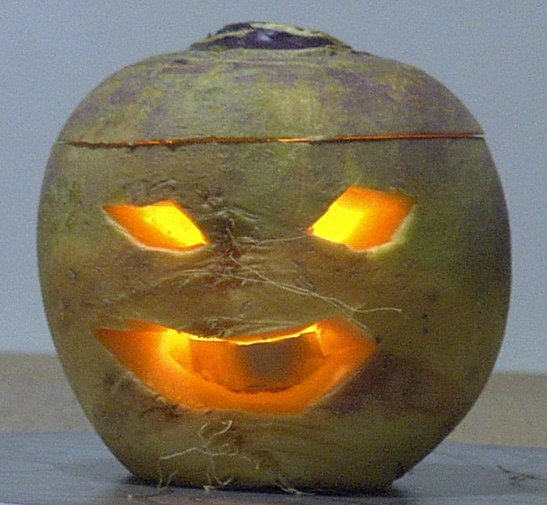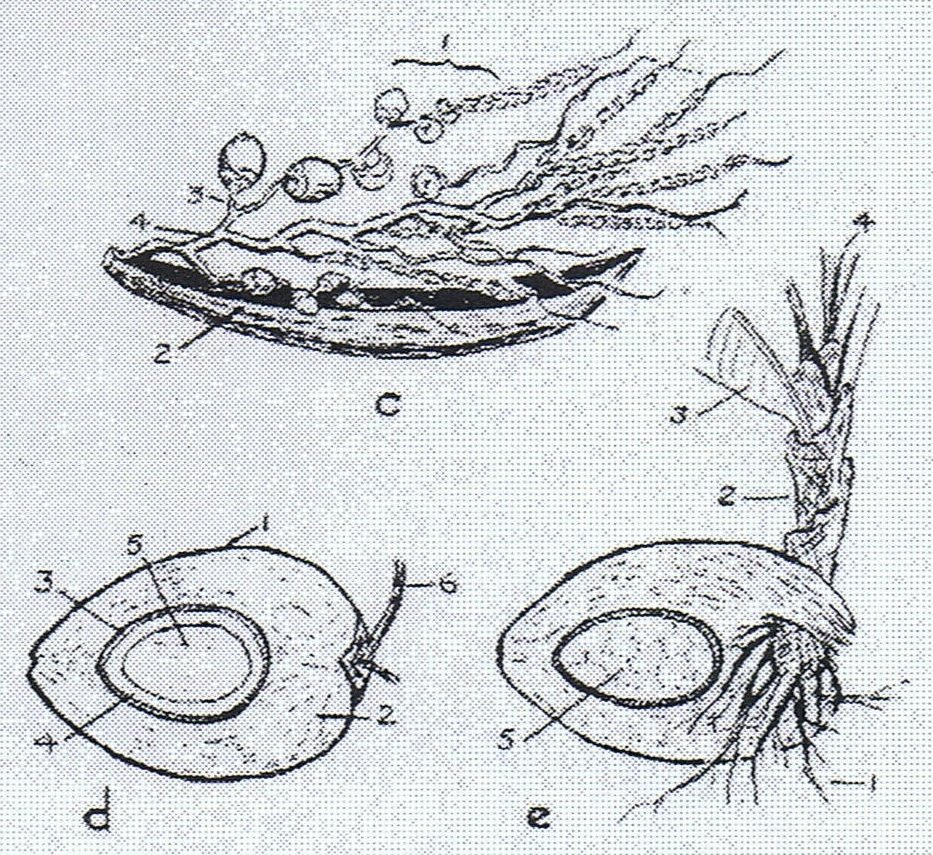|
TRANSLATIONS
It is time to
look at the last
summary page of
hua poporo:
 |
 |
 |
 |
|
Ga4-7 |
Ka5-4 |
Ca1-19 |
Ca1-20 |
|
midsummer |
autumn
equinox |
The
'black drops' are not really black, they are light, and they
represent seasons of the sun. According to Vanaga,
poporo haha is
a sort of golden thistle, which I think would have suited the 'sun
berries' better as a name. Moreover, haha alludes to the back
side, and also means 'entrance' - entrance to the back side (tu'a):
| Haha
1. Mouth (oral cavity, as opposed to gutu, lips). 2.
To carry piggy-back. He haha te poki
i toona matu'a, the child took his father on his back. Ka
haha mai, get onto my back (so I may carry you). Vanaga.
1. To grope, to feel one's way; po haha,
darkness, obscure. 2. Mouth, chops, door,
entrance, window; haha pipi, small mouth; haha
pipiro, foul breath; ohio haha, bit of bridle; tiaki
haha, porter, doorkeeper. Churchill. |
On your back
side you cannot see and you have to grope (haha).
Metoro's
poporo seems to point forward (if we read popo-ro as
raindrops) - to the coming tu'a side. The hua part (of his
hua poporo), on the
other hand, points in the other direction - to the time when sun is enabling
the fruits to ripen. Therefore, the glyphs seem to tell about breadfruit
rather than nightshade (if there were only two alternatives to choose from).
Ga4-7 and
Ga1-20 have no 'fruits', because the solar 'breadfruit stem' is not
there. Instead a lunar 'thread' tells about the tu'a time. First comes a hua season, then a
tu'a season.
Comparing
Ga4-7 with Ka5-4 we can see the shape of the moon at bottom right in Ga4-7
while in Ka5-4 the moon sickle is located at left. At left in Ga4-7 we
instead find the solar 'breadfruit stem'. Both sun and moon are referred to
in the texts, though while in G focus still is on the sun the text in K has focus
on the arrival of the moon (tu'a) season.
The 'berries'
in the hua poporo glyphs indicate how the 'fruits' are ripe for
harvest, they will fall and a new dark season will enter (popo).
The 'balls' (popo) announce the coming drops. Maybe - as if by
sympathetic magic - the fruits will fall with the rain.
|
I have no
immediate
negative
reactions to what
has been written
here. The mouth
(haha)
has become more
understandable -
it is the mouth
of time in the
west.
Ko koró
(December) maybe
alludes to coco
(in coco-nut) by
way of
koko-ro, the
'tear' (ro)
ought to be
there, at summer
solstice:

|
...
The
Mangaian
creation
myth
of
Vatea,
Bright
Sky
(Wakea,
Atea),
is
unique
in
Polynesian
mythology.
In
the
tapering
root
of
the
spherical
world,
which
departs
from
the
world-egg
form
by
being
a
kind
of
cosmic
turnip,
in
the
narrow
land
of
Te
Aiti-te-apiapi,
'where
little
could
be
done',
dwelt
the
essence
of
human
growth,
a
spirit
called
Vari-ma-te-takere,
the
Mud-and-the-bottom-of-everything
... |
|
Koka
Pau.:
fern,
bracken.
Ta.:
oaha,
Asplenium
nidus.
Mq.:
koka,
breadfruit,
a
banana.
Sa.:
'o'a,
a
tree.
Churchill. |
|
Though
koka
was
also
a
word
used
by
Metoro
for
insect
or
some
kind
of
insect
(presumably
cockroach).
At
summer
solstice
insects
should
be
expected.
Interesting
is
Marquesan
koka
for
both
breadfruit
and
banana,
symbols
- I
guess
-
for
sun
(head)
respectively
moon
(heart
&
entrails).
If
sun
could
be
called
a
spider
(hônu
and
Hawaiian
ku'uku'u),
another
insect
should
play
the
role
of
fly
(eagle).
Ku'uku'u
is a
word
reminding
us
about
the
Planter,
Kuukuu. |
Roro is
close to coco,
and we can
imagine a cluster
of allusions:
koko-ro,
popo-ro,
ro-ro and
pa-roro. We
need to be more
precise, and
Ko Koró
should at least
be equal to
kokoro:
| Kokoro Width, expanse; wide, spacious.
Te kokoro o te hare, the expanse of a wide house. Vanaga.
To widen, to expand. Churchill. |
At the sunmit,
on top of the
mountain, the
horizon widens,
kokoro.
This is
presumably the
primary meaning,
and ko koro
(the festivity
month) a
secondary
wordplay. Though
who knows if it
is the hen or
the chicken
which is
primary?
"A man once said
to his careless
son: The world
is as sharp as a
knife. If you
don't watch out,
you'll fall
right off. His
son replied that
the earth was
wide and flat;
no one could
fall off. And as
he kicked at the
ground to show
how solid and
reliable it was,
he ran a
splinter into
his foot and
died soon
after." (Sharp
as a Knife)
In
Kapingamarangi
the flower of
the coconut tree
(c) was taume,
also easy to
associate with
hua poporo:

In the moon
calendar of
Mamari
tapume may
have been the
21st night - a
number beyond
a final 20:
|
6th
period |
 |
 |
see
right |
 |
 |
 |
 |
 |
|
Ca8-4 |
Ca8-5 |
|
Ca8-6 |
Ca8-7 |
Ca8-8 |
Ca8-9 |
Ca8-10 |
|
glyph
numbers
in
the
calendar: |
Tapume |
Matua |
Orongo |
|
47 |
48 |
- |
49 |
50 |
51 |
52 |
53 |
Orongo we
now can
interpret as
'O-ro-go,
but oro-go
is also a
probable
reading:
|
Oro
1.
To
flit
in
the
air
(of
a
bird),
turning
and
flying
up
and
down.
2.
To
file,
to
scratch,
to
scrub,
to
grind,
to
sharpen;
ka-oro
te
kumara,
grind
the
sweet
potatoes;
ka-oro
te
hoe,
sharpen
the
knife.
Orooro,
to
rub,
to
polish,
to
shine.
Vanaga.
Oroina,
to
choke
on a
fish
bone.
Orooro,
to
whet,
to
sharpen
(horo).
Churchill. |
Ora is
'a.m.' and
oro is
'p.m.', I
imagine. Or,
maybe, uru
is 'p.m.' and
oro 'noon'.
| Go Pau.:
goge, to break. Ma.: ngongengonge, crippled. Churchill.
Pau.: gogo, the navel and cord. Mgv.: gogo,
id. 2. Mgv.: gogo, a conical hole. Ta.: oo, a large
cavity. Ha.: no, a hole left to draw off water from taro
patches. 3. Mgv.: gogo, thin cheeks, sunken eyes. Ta.: tu-oo,
wasted away. Ma.: ngongo, emaciated. Churchill.
Sa.: ngongo, the tern (Sterna longipennis).
To., Niuē; ngongo,
the sea gull. Futuna: ngŏngŏ,
the name of a bird. Vi.: ngongo,
a sea bird. Churchill 2. |
Japanese gogo
means p.m.
The sea-gull (gogo) was
crippled, had
'broken wings',
I read recently
somewhere, maybe
in Sharp as a
Knife. But I
cannot find it
again.
Beyond 'noon' (Ko
Koró) we
have first
Tua haro and
then
Tehetu'upu:
|
2nd
quarter |
3rd
quarter |
|
Tagaroa
uri
(October) |
Tua
haro
(January) |
|
Cleaning
up
of
the
fields.
Fishing
is
no
longer
taboo.
Festival
of
thanksgiving
(hakakio)
and
presents
of
fowl. |
Fishing.
Because
of
the
strong
sun
very
little
planting
is
done. |
|
Ko
Ruti
(November) |
Tehetu'upú
(February) |
|
Cleaning
of
the
banana
plantations,
but
only
in
the
morning
since
the
sun
becomes
too
hot
later
in
the
day.
Problems
with
drought.
Good
month
for
fishing
and
the
construction
of
houses
(because
of
the
long
days). |
Like
the
previous
month.
Some
sweet
potatoes
are
planted
where
there
are
a lot
of
stones
(pu). |
|
Ko
Koró
(December) |
Tarahao
(March) |
|
Because
of
the
increasing
heat,
work
ceases
in
the
fields.
Time
for
fishing,
recreation,
and
festivities.
The
new
houses
are
occupied
(reason
for
the
festivities).
Like
the
previous
month,
a
good
time
for
surfing
(ngaru)
on
the
beach
of
Hangaroa
O
Tai. |
Sweet
potatoes
are
planted
in
the
morning;
fishing
is
done
in
the
afternoon. |
Fishing in
Tua Haro
could be
connected with
Eb3-17--18:
The 'conical
hole' (gogo) may
be related to
Te Hetu'u Pu
(I think
about pu
meaning hole).
The hot stones (pu)
used for
'cooking' in an
umu
presumably are
alluded to - to
put down a lot
of (hot) stones
in the
(conical?) hole
is necessary.
The hot sun is
going down into
a hole in the
earth (hetu'u
pu).
The number of
possible wordplays
are many. Omo
means sucking
(by the 'infant
eaglet', cfr
Omotohi,
Ca7-24) and
umu,
therefore, ought
to be its
opposite -
returning to
'mother' what
has been taken.
 |
 |
|
Ca7-24 |
Ca8-29 |
|
36 |
72 |
Maybe, in Ka5-4,
the 'mother
ship' in the
center is
'sucking' warmth
from the 4 sun
quarter 'balls'?

Ca7-24 is the
halfway station
and Ca8-29 the
end station. 29
means dark moon.
If the same kind
of pattern was
used in the
London Tablet
text, then Ka5-4
ought to be the
halfway station,
not the end
station. The
'mother ship' is
released (cut
off), rather,
from its 'root'.
The elongated
oval (the
'canoe')
presumably
indicates how
the 1st 'year'
is completed,
its cycle is
closed. This
type of sign
agrees with the
Omotohi
glyph, yet in
Ka5-4 the extra
signs are
outside
(alluding to
sun) rather than
inside (moon).
Let us count
glyphs. At
haú in the
glyph dictionary
the K structure
is summarized:
|
K |
period
no. |
number
of
glyphs |
|
1,
2, 3 |
7 +
3 +
4 =
14 |
28 |
14 |
|
4,
5, 6 |
3 +
2 +
3 =
8 |
22 |
|
7,
8, 9 |
2 +
2 +
2 =
6 |
28 |
|
10,
11,
12 |
2 +
3 +
2 =
7 |
*28 |
35 |
|
13,
14,
15 |
3 +
2 +
3 =
8 |
43 |
|
16 |
*13 |
*56 |
|
17
|
3 |
*29 |
*59 |
|
18,
19,
20 |
*7 +
4 +
4 =
*15 |
*74 |
|
21,
22,
23
|
3 +
6 +
2 =
11 |
*85 |
|
24,
25,
26 |
2 +
3 +
3 =
8 |
30 |
*93 |
|
27,
28,
29 |
5 +
4 +
5 =
14 |
*107 |
|
30,
31 |
4 +
4 =
8 |
*115 |
|
32,
0 |
3 +
7 =
10 |
10 |
*125 |
Ka5-4 is the 1st
glyph in period
9, therefore its
ordinal number
in the calendar
is 27 (= 3 * 3 *
3).
If 27 is the
halfway station,
then 54 will be
the end station.
The glyph we
search for is
located
(unhappily) in
the 16th period:
|
13 |
 |
 |
 |
|
Ka5-13 |
Ka5-14 |
Kb1-1 |
|
36 |
37 |
38 |
|
0 |
1 |
2 |
|
14 |
 |
 |
|
Kb1-2 |
Kb1-3 |
|
39 |
40 |
|
3 |
4 |
|
15 |
 |
 |
 |
|
Kb1-4 |
Kb1-5 |
Kb1-6 |
|
41 |
42 |
43 |
|
5 |
6 |
7 |
|
16 |
 |
 |
 |
 |
|
Kb1-7 |
Kb1-8 |
Kb1-9 |
Kb1-10 |
|
44 |
45 |
46 |
47 |
|
8 |
9 |
10 |
11 |
 |
 |
 |
 |
|
Kb1-11 |
Kb1-12 |
Kb1-13 |
Kb1-14 |
|
48 |
49 |
50 |
51 |
|
12 |
13 |
14 |
15 |
 |
 |
... |
... |
 |
|
Kb1-15 |
Kb1-16 |
Kb1-101 |
|
52 |
53 |
*54 |
*55 |
*56 |
|
16 |
17 |
18 |
19 |
20 |
|
17 |
 |
 |
 |
|
Kb1-102 |
Kb1-103 |
Kb1-104 |
|
*57 |
*58 |
*59 |
|
21 |
22 |
23 |
|























